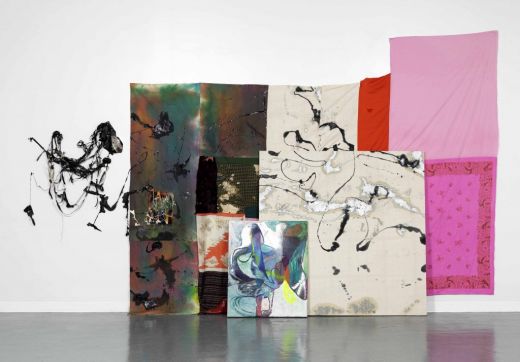Chlorophyll Bluess: Molly Zuckerman-Hartung
Marcos Valella

Adulterate, 2013. Acrylic,bleach,enamel,latex and paper collage on cut,draped and sewn cloth on canvas 95 x 167 x 12 in. (241.3 x 424.18 x 30.48 cm)
Diana Lowenstein Gallery
As you enter the gallery you encounter the name of the exhibition, Chlorophyll Bluess, painted directly on the wall in neon pink and blue. You create a narrative around this seemingly sudden inner impulse to paint, imagining the artist up on a ladder or on a chair with a can of spray paint and the lace placemat she used for a stencil. This is the same type of sequence of actions that is pictured when you look at assemblage art. A narrative is formulated around the artist building the object.
Fourteen works fill the gallery. Among the works, two pieces in the exhibition have no titles or dates and are not on the gallery list. One is a heated chrome towel rack sticking off the wall like a street sign with the stencil-lace placemat that was used for the title wall elegantly placed over. The other is just a beautiful walking cane hanging from the wall. The rest of the works—hung traditionally are a hodgepodge of materials and infinite possibilities. All are over-worked and all function under the term of post-production art.
She destroys form: color everywhere, pouring, spraying, bleaching, nailing, screwing, sewing, stringing, linking, collaging, reusing, repurposing, and reworking images, textiles, fabrics, and paper. All clash together in what first seems like a naïve push to expand the possibilities of abstraction. Within all the clutter of materials and gestures resides a very specific historical mark—Jackson Pollock’s notorious drip.
To create this drip she must stop, remove the painting off the wall and place it on a table or floor, dip the brush in the correct paint, then wave her hand and arm over the canvas. Then she must wait for the paint to dry before placing the canvas up right. Stopping, changing the position of the painting, and then waiting not only sets a specific pace—like a drum beat it verifies the painting through performance. Unlike the narrative we arrive at with assemblage, this narrative does not function as an artist-at-work, but as an artist as art. We might agree with Allan Kaprow, who pinned Pollock as more of a performer. When Pollock stood over his canvas and dripped paint, the act of painting was the art work, and the completed painting functions only as a documentation of that performance. The drip illustrating the action of shifting the painting from vertical to flat and back—is represented and repeated in all of Zuckerman-Hartung’s paintings, save for the oldest two. This serves as a marker for abstraction as a point of possible performance. In contradiction, the narrative generated from the groupings of ironic gestures and signifiers removes any and all possibilities of a novel abstraction. A hole forms between abstraction as a dead language and abstraction existing as performance. This circular argument cannot confirm its meaning; optimistically, we must look elsewhere. Zuckerman-Hartung sets up a model of consumption and disposal based on the love for the commodity and its immediacy. She seeks not to modify what is, nor to propose solutions, but to embrace a new form of freedom “behind” the canon. Hopefully, we can recognize a cane loosely hung from the top of a wall, not as a readymade, not as a symbol, nor as a performative action or an impulsive gesture—but simply as painting.










